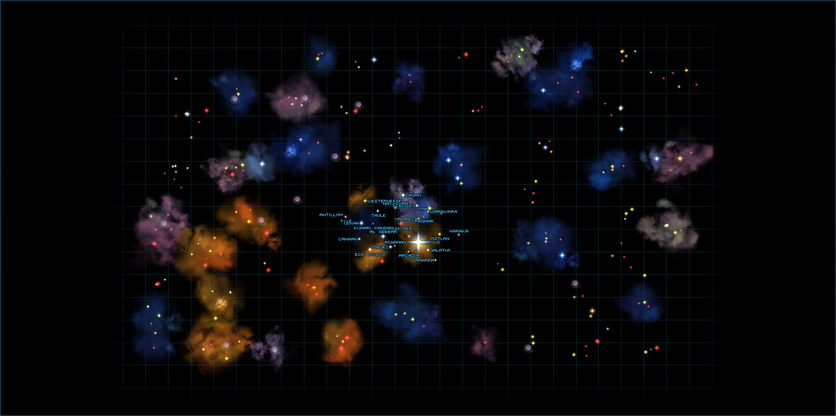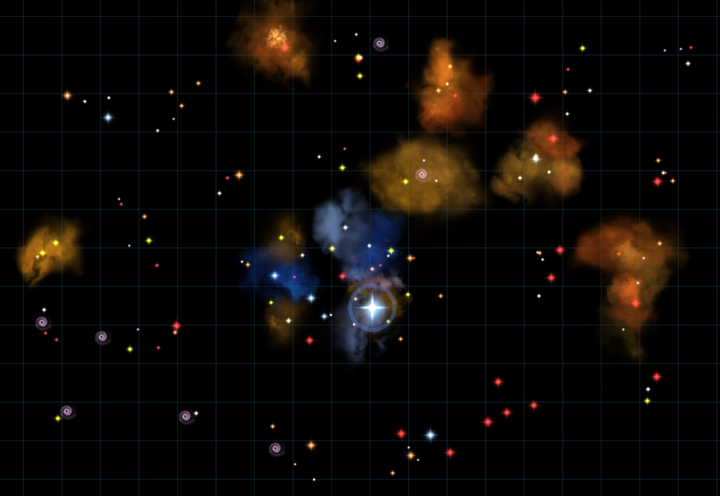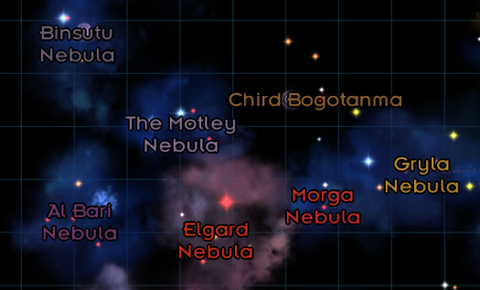Sector
The Persean Sector is the region of space in the Milky Way galaxy where Starsector takes place. There are dozens of systems, which can be classified in two groups: the Core Worlds, and the outer systems. As of the current version, most of the sector is procedurally generated, which means that the sector will vary from campaign to campaign. Even the Core Worlds have some measure of procedural generation, seen in their outer systems.
The Sector has two types of generation settings for its seed: Age and Size. Age will alter the amount of planets, resources and star colors that will spawn in the Sector's constellations, while Size will alter the amount of star systems in the Sector.
The top image's seed is MN-4486500820655127274. M stands for "Mixed", which makes it so that different constellations have different ages. N stands for "Normal", which means the Sector has the normal amount of star systems on it.
Starscape and Constellation Names.
The Starscape of the Sector shows you the expected age of the systems (Planets and stars) within any given constellation. Generally speaking, orange/yellow is old, purple is mixed/average, and blue is young. A lack of a cloud may indicate a particularly old system, as seen below in this old Sector.
Old Sector with large empty spots between clouds - Especially in the far left.
Constellation Names
Constellations have colored names on the star map. This is to increase readability more than any indication of the age of the constellation or it’s constituent parts.
Star Systems
Each point of light on the Sector map is a star system that can be visited. When hovered over more information is displayed via a tooltip. There are also some star-less and hard-to-spot Nebulas with planetary bodies.
- The Name, Type, Exploration status and containing Consellation are always visible
- A Navigation Data header will always display it's distance, the fuel needed to fly there, and the time it will take to arrive.
- A Planets header appears for explored systems, showing how many planets are unsurveyed, partially surveyed, or completely surveyed
- A Markets header will appear for inhabited systems, showing each colony/market with it's name, faction, planet type and size
Star Types
| Star Type | Apparent
Colour |
Apparent
Size |
Rarity | Notes |
|---|---|---|---|---|
| Red Supergiant | Red | Large | Rare | Red & orange giants are most often found in old constellations.
Giant stars often have more orbiting bodies than normal. These stars have many barren and irradiated worlds, but still have gas giants and habitable worlds. |
| Red Giant | Red | Large | Common | |
| Orange Giant | Orange | Large | Rare | |
| Blue Supergiant | White | Large | Rare | Blue giants are usually found in young constellations.
They have fewer habitable planets, but more lava worlds (and thus more minerals). |
| Blue Giant | White | Large | Common | |
| Yellow Star | Average | Average | Abundant | These are average stars, found everywhere.
They are most common in young constellations. A normal distribution of planet types can be expected. |
| Orange Star | Orange | Small | Abundant | |
| Red Dwarf | Red | Small | Abundant | |
| Brown Dwarf | Red | Tiny | Rare | These stars are cold and rarely habitable.
They appear very similar to red dwarfs on the map. |
| White Dwarf | White | Small | Common | These almost-neutron stars are common in old constellations.
They have many cold worlds but few habitable ones. |
| Neutron Star | White | Tiny | Rare | One step from a black hole, I hope you like radiation!
Rare in young constellations, and rarely habitable. |
| Black Hole | Purple | Large
(Swirl) |
Rare | It's a black hole. Quite rare, especially in young constellations.
Suprisingly habitable (don't get your hopes up, though) and can have many planets. |
| Nebula | n/a | Large | Extremely
Rare |
These are rare in older systems, and hard to spot.
Nebulas are rarely habitable and are very cold. |
History
The Sector was settled by the Human Domain, a galaxy-spanning human superpower. About 206 Earth years (known as "Cycles" in the Sector) before the start of the game, the gates connecting the Sector to the rest of the galaxy failed mysteriously in an event known as the Collapse. Cut off from the stability and economic support of the Domain, the Sector was soon hit with a range of calamities including famine, brigandage, technological regression, and a general breakdown of society—and that's without mentioning the First AI War that ravaged much of the outer reaches of the sector. In response, several factions such as the Hegemony formed to restore some semblance of order.
Due to the Collapse and the First AI War, most of the Persean Sector's surviving people live in the center of the sector in a 12 light-years tall and 18 light-years wide cluster of systems known as the Core Worlds.
Changelog History
0.95a
- [REDACTED] added.
- [SUPER ALABASTER] structure and ships added.
0.9a
- [REDACTED] added.
0.8a
- Procedural Generation, Outer Systems and Constellations added.
- [REDACTED] ships and [REDACTED] stations added.
- Al Gebbar, Canaan, Galatia, Isirah, Kumari Kandam, Mayasura, Naraka, Thule, Tia-Taxet, Tyle, Westernesse and Zagan are added.
- Yma B renamed as Warawara.
0.7a
0.65a
- Arcadia, Eos Exodus, Magec, and Valhalla are added.
0.6a
- Hyperspace is added.
- Askonia is added.
0.5a
- Corvus is added.
References
- UpdateMe
- Star System
- Lore



